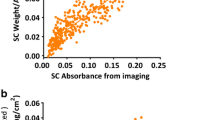Abstract
Attenuated total-reflectance infrared (ATR-IR) spectroscopy has been used to follow the penetration of a model compound (4-cyanophenol; CP) across human stratum corneum (SC) in vivo, in man. CP was administered for periods of 1, 2, or 3 hr, either (a) as a 10% (w/v) solution in propylene glycol or (b) in an identical vehicle which also contained 5% (v/v) oleic (cis-9-octadecenoic) acid. At the end of the treatment periods, SC at the application site was progressively removed by adhesive tape-stripping. Prior to the removal of the first tape-strip, and after each subsequent tape-strip, an ATR-IR spectrum of the treated site was recorded. The presence of CP, as a function of position in the SC, was monitored spectroscopically via the intense C≡N stretching absorbance at 2230 cm−1. The absolute amount of CP, as a function of SC depth, was determined by "spiking” the applied solutions with 14C-labeled compound and subsequent liquid scintillation counting of the removed tape-strips. The presence of oleic acid in the applied formulation significantly increased the rate and extent of CP delivery as evaluated by either spectroscopy or radiochemical analysis. Furthermore, the ATR-IR and direct 14C analysis of CP as a function of SC position were highly correlated. These data strongly support, therefore, the validation of ATR-IR as a quantitative tool to assess percutaneous penetration in vivo.
Similar content being viewed by others
REFERENCES
R. H. Guy, A. H. Guy, H. I. Maibach, and V. P. Shah. The bioavailability of dermatological and other topically administered drugs. Pharm. Res. 3:253–262 (1986).
W. Schalla, J. C. Jamoulle, and H. Schaefer. Localization of compounds in different skin layers and its use as an indicator of percutaneous penetration. In R. L. Bronaugh and H. I. Maibach (eds.), Percutaneous Absorption: Mechanisms—Methodology—Drug Delivery, 2nd ed., Marcel Dekker, New York, 1989, pp. 283–312.
A. Zesch. Methods for evaluation of drug concentration in human skin. In R. Brandau and B. H. Lippold (eds.), Dermal and Transdermal Absorption, Wissenschaftliche Verlagsgesellschaft, Stuttgart, 1982, pp. 116–132.
A. Rougier. Predictive measurement of in vivo percutaneous absorption. In R. C. Scott, R. H. Guy, and J. Hadgraft (eds.), Prediction of Percutaneous Penetration: Methods, Measurements, Modelling, IBC Technical Services, London, 1989, pp. 19–33.
A. Rougier, M. Rallis, P. Krien, and C. Lotte. In vivo percutaneous absorption: A key role for stratum corneum/vehicle partitioning. Arch. Dermatol. Res. 282:498–505 (1990).
D. Bommannan, R. O. Potts, and R. H. Guy. Examination of stratum corneum barrier function in vivo by infrared spectroscopy. J. Invest. Dermatol. 95:403–408 (1990).
V. H. W. Mak, R. O. Potts, and R. H. Guy. Percutaneous penetration enhancement in vivo measured by attenuated total reflectance infrared spectroscopy. Pharm. Res. 7:835–841 (1990).
V. H. W. Mak, R. O. Potts, and R. H. Guy. Oleic acid concentration and effect in human stratum corneum: Non-invasive determination by attenuated total reflectance infrared spectroscopy in vivo. J. Contr. Rel. 12:67–75 (1990).
R. O. Potts, D. B. Guzek, R. R. Harris, and J. E. McKie. A non-invasive, in vivo technique to quantitatively measure water concentration of the stratum corneum using attenuated total-reflectance infrared spectroscopy. Arch. Dermatol. Res. 277:489–495 (1985).
R. J. Scheuplein. A survey of some fundamental aspects of the absorption and reflection of light by tissue. J. Soc. Cosmet. Chem. 15:111–122 (1964).
N. J. Harrick. Internal Reflection Spectroscopy. Harrick Scientific, 1979.
N. Higo, D. Bommannan, R. O. Potts and R. H. Guy. Measurement of percutaneous penetration in vivo: Spectroscopic and radiochemical methodologies. Proc. Int. Symp. Control. Rel. Bioact. Mater. 17:413–414 (1990).
R. O. Potts, V. H. W. Mak, R. H. Guy, and M. L. Francoeur. Strategies to enhance permeability via stratum corneum lipid pathways. Adv. Lipid Res. 24:173–210 (1991).
D. M. Byler and H. Susi. Examination of the secondary structure of proteins by deconvolved FTIR spectra. Biopolymers 25:469–487 (1986).
J. H. Keighley. Infra-red spectroscopy. In Jones (ed.), Introduction to the Spectroscopy of Biological Polymers, Academic Press, New York, 1976, pp. 17–80.
D. A. Weigand and J. R. Gaylor. Removal of the stratum corneum in vivo: An improvement on the cellophane tape-stripping technique. J. Invest. Dermatol. 60:84–86 (1973).
H. Schaefer, G. Stüttgen, A. Zesch, W. Schalla, and J. Gazith. Quantitative determination of percutaneous absorption of radiolabelled drugs in vitro and in vivo by human skin. Curr. Prob. Dermatol. 7:80–94 (1978).
H. Schaefer A. Zesch, and G. Stüttgen. Skin Permeability, Springer, Berlin, 1982.
B. Ongpipattanakul, R. R. Burnette, R. O. Potts, and M. L. Francoeur. Evidence that oleic acid exists in a separate phase within stratum corneum lipids. Pharm. Res. 8:350–354 (1991).
M. L. Francoeur, G. M. Golden, and R. O. Potts. Oleic acid: Its effects on stratum corneum in relation to (trans)dermal drug delivery. Pharm. Res. 7:621–627 (1990).
G. M. Golden, J. E. McKie, and R. O. Potts. Role of stratum corneum lipid fluidity in transdermal drug flux. J. Pharm. Sci. 76:25–28 (1978).
A. C. Watkinson, A. L. Bunge, J. Hadgraft, and A. Naik. Computer simulation of penetrant concentration-depth profiles in the stratum corneum. Int. J. Pharm. 87:175–182 (1992).
Author information
Authors and Affiliations
Rights and permissions
About this article
Cite this article
Higo, N., Naik, A., Bommannan, D.B. et al. Validation of Reflectance Infrared Spectroscopy as a Quantitative Method to Measure Percutaneous Absorption In Vivo . Pharm Res 10, 1500–1506 (1993). https://doi.org/10.1023/A:1018987612155
Issue Date:
DOI: https://doi.org/10.1023/A:1018987612155



